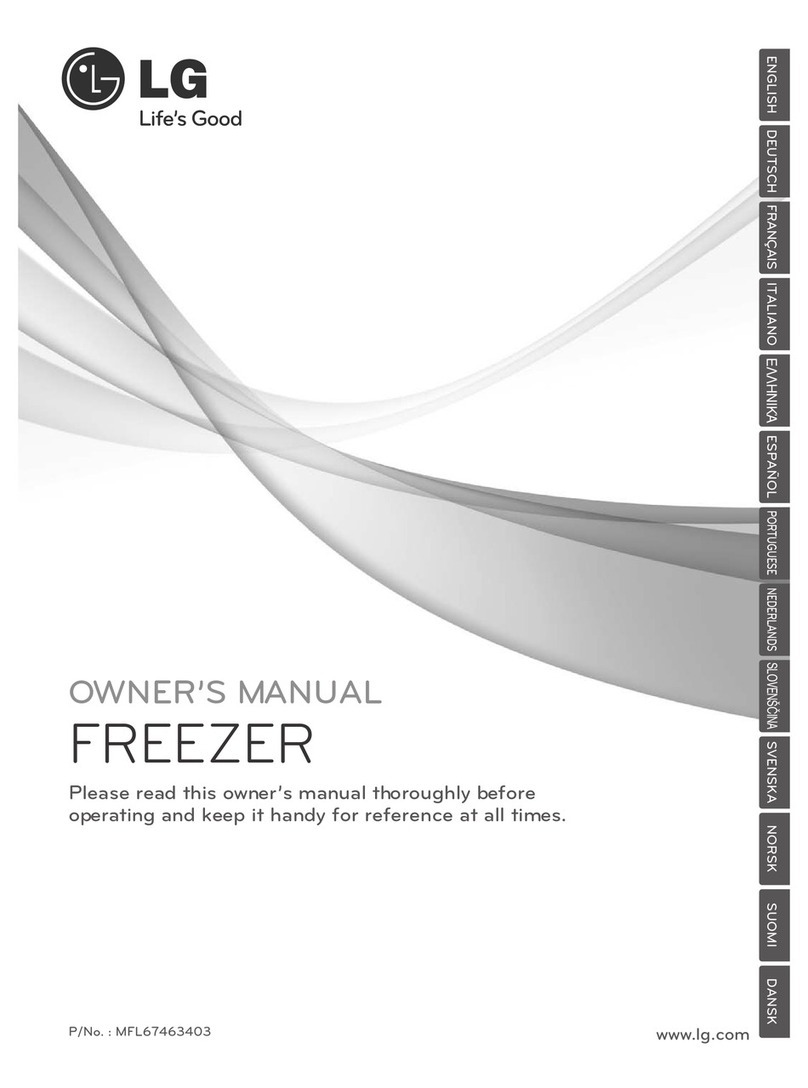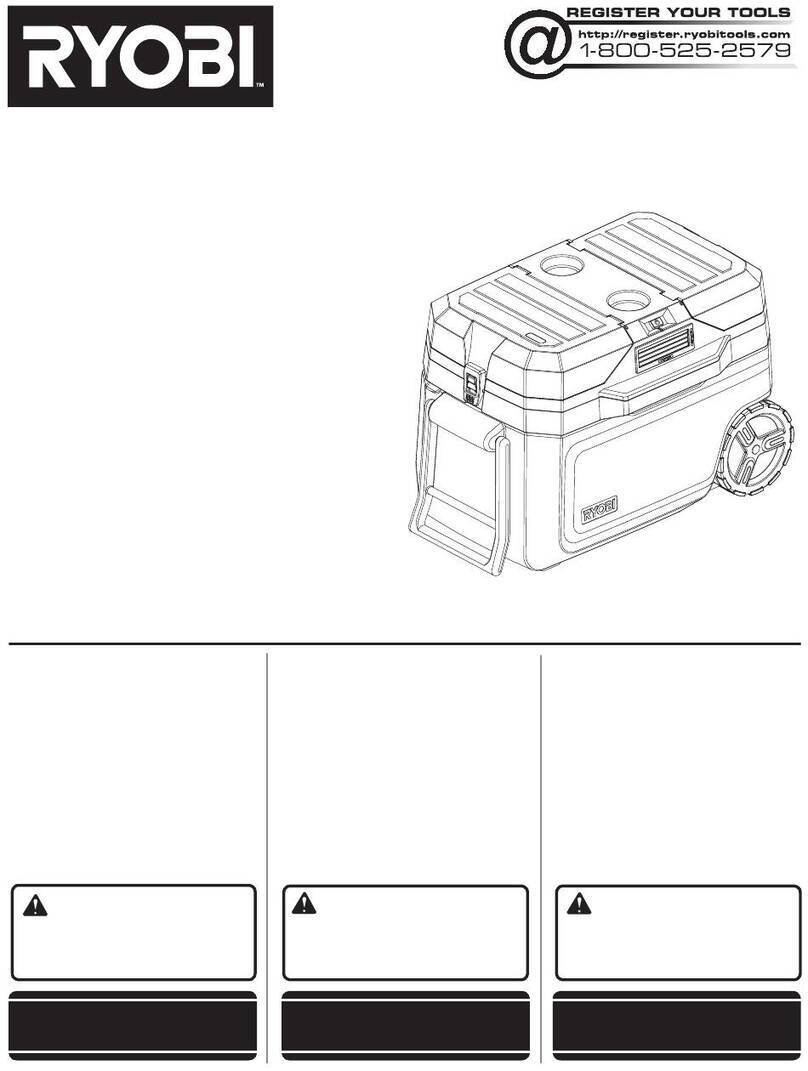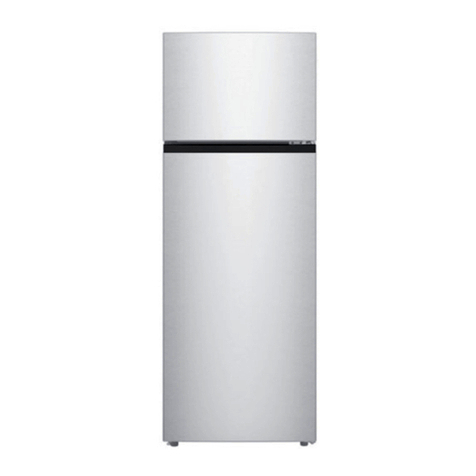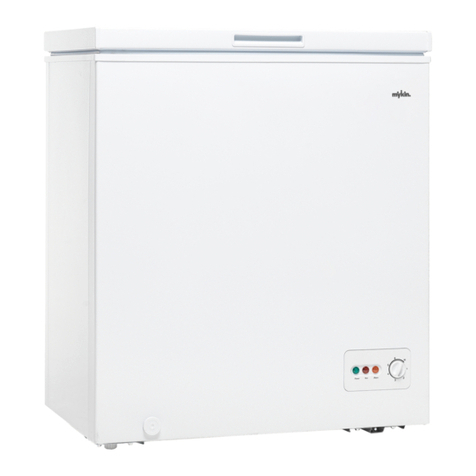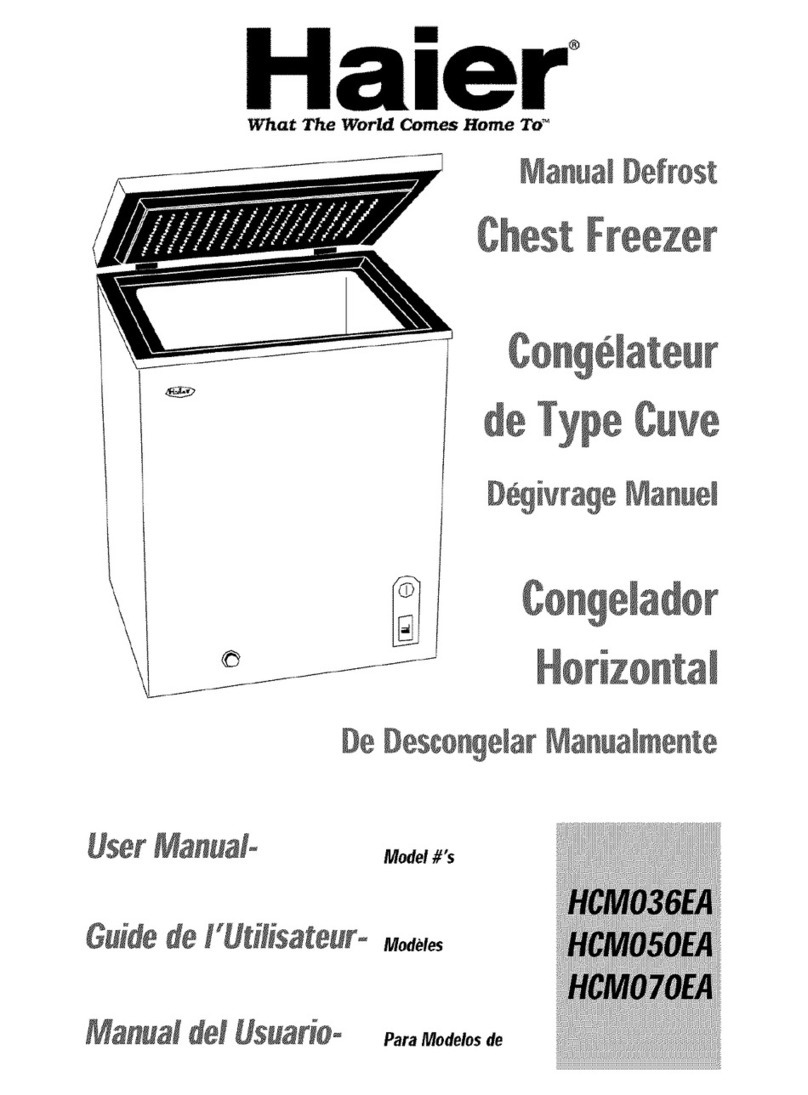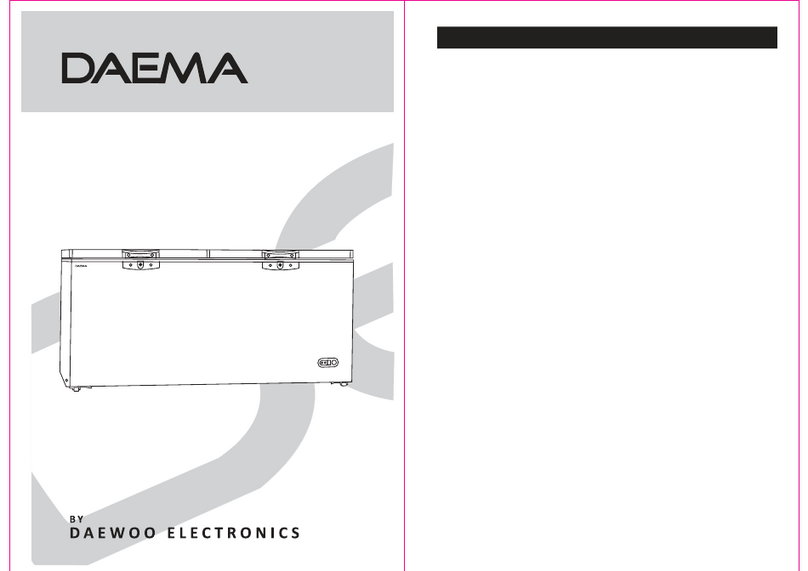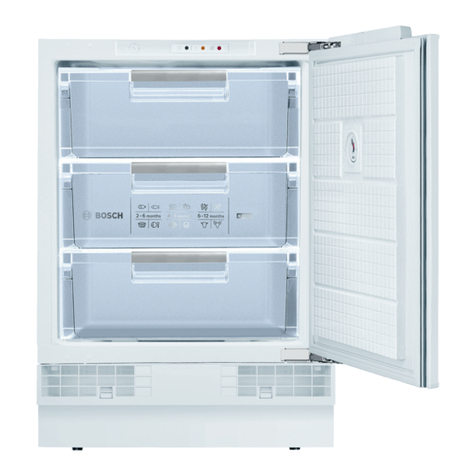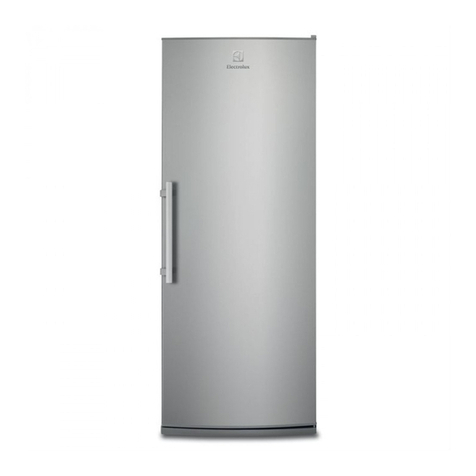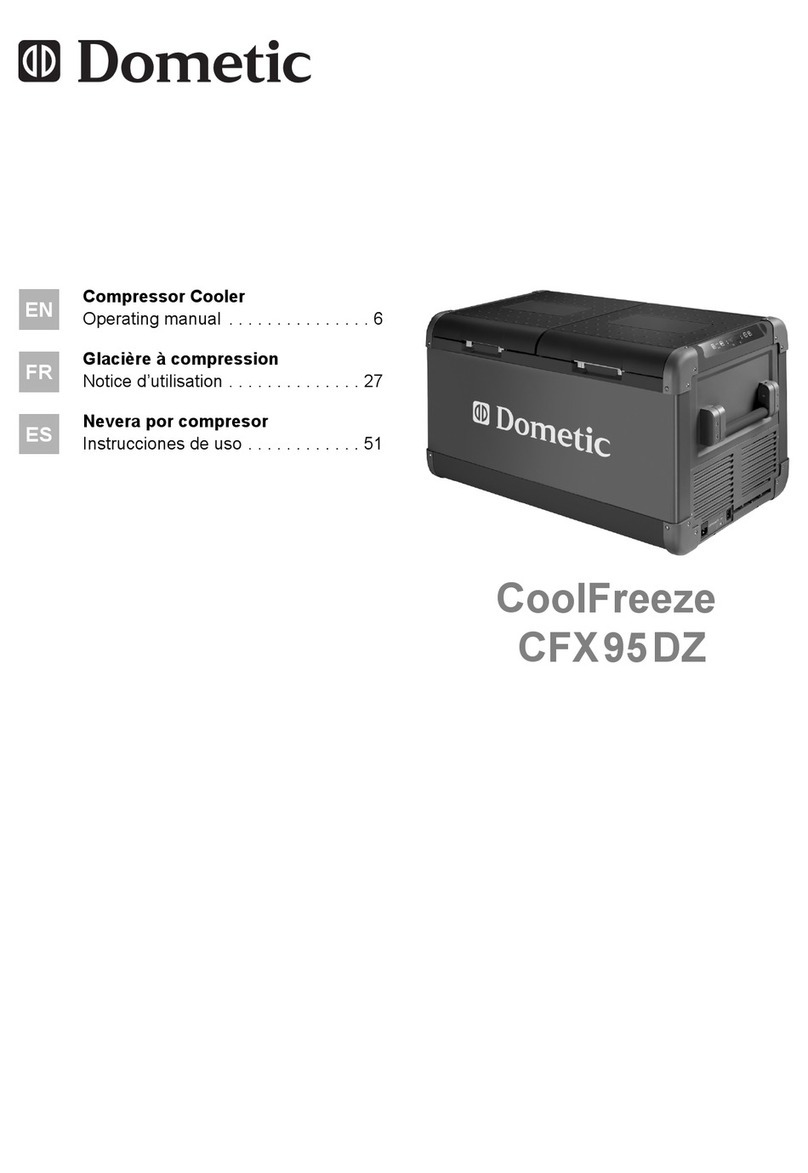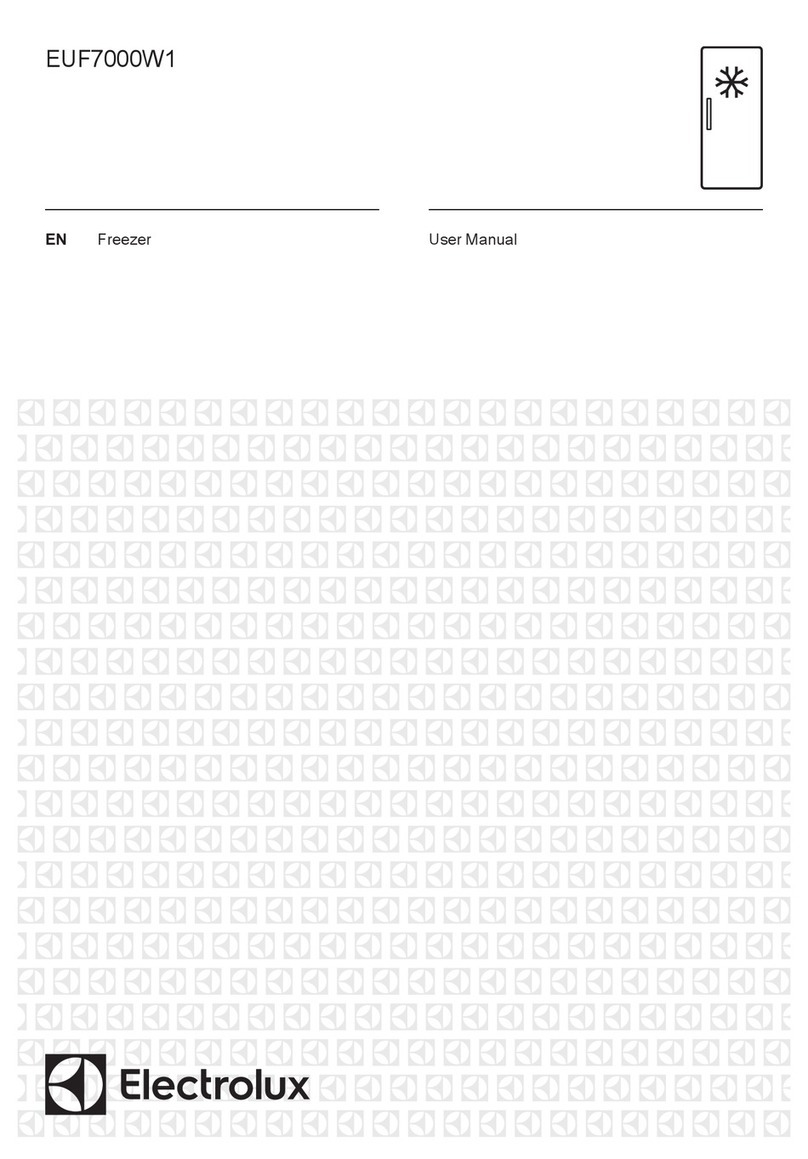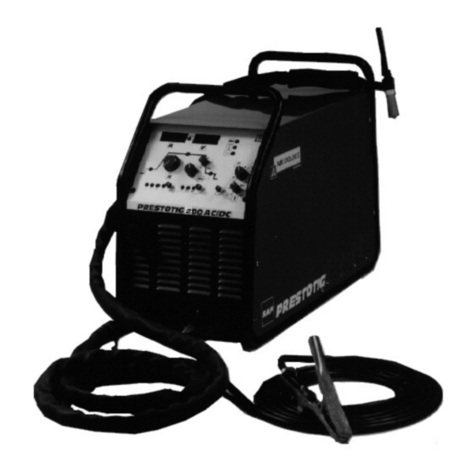Festivo 75 CF User manual

INSTRUCTIONS FOR
INSTALLATION AND USE
It is strongly adviced that these instructions be
readcarefullypriortotheinstallationand
operationyournewrefrigerator/freezer.
Cooling Cabinet / Freezer
75 CF

2
0712
SAFETYPRECAUTIONS ...................................................... 3
STIPULATIONS FOR USE .................................................... 3
SAFETYINFORMATION ....................................................... 4
Before starting to use the appliance ............................. 4
INSTALLATION ..................................................................... 4
Location ......................................................................... 4
Electric connection ........................................................ 5
Balancing and locking the castors ................................ 6
Prevention of tilting ....................................................... 6
Fitting the bottom front plate ........................................ 6
Fitting the cooling cabinet shelves ............................... 7
Adjustment of the door ................................................. 7
Change between right- and left-hand door opening .... 7
FUNCTIONALDESCRIPTION .............................................. 8
SWITCHESAND THERMOSTATS ........................................ 9
Switches ........................................................................ 9
Electronic thermostat .................................................... 9
Fresh storage thermostat, adjusting ............................ 9
USING THE COOLING CABINET /FREEZER ..................... 10
SWITCHING ON ................................................................. 10
SWITCHING OFF ............................................................... 10
ADJUSTINGTHE TEMPERATURE..................................... 11
SPEEDYCOOLING ............................................................ 11
SPEEDYFREEZING ........................................................... 11
SOUNDS DURING OPERATION ........................................ 12
STORAGE OF FOODSTUFFS ............................................ 12
Cool storage ................................................................ 12
Fresh storage .............................................................. 12
Frozen storage ............................................................ 13
Putting foods in the cooling cabinet /freezer.............. 13
Example of arrangement ............................................. 14
FREEZING .......................................................................... 15
CLEANING ......................................................................... 16
Cleaning the cooling cabinet ....................................... 16
Cleaning the freezer .................................................... 17
Cleaningthe mechanism ............................................. 17
FUNCTIONALDISORDERS ............................................... 18
Correcting minor disorders ......................................... 18
ERRORMESSAGES .......................................................... 19
DISPOSAL OF THEAPPLIANCE ....................................... 20
Table of Contents

3
In connection with installation, it is essen-
tial to fix a tilting guard also.
When cleaning the cooling cabinet /free-
zer, switch off the voltage using the main
switch and remove the plug from the
socket.
Alcoholic substances, or preserves con-
taining them, e.g. pickled cucumber and
beetroot, must be kept in a tightly closed
container in a vertical position.
Opened bottles of sparkling wine must not
be kept in the door compartments, becau-
se vibration from opening the door may
make the cork pop out, which could cause
injury.
Glass bottles containing liquids that freeze
should not be kept in the freezer, because
the bottles would break.
Materials that are liable to explode must
not be kept in the cooling cabinet /freezer.
The door must not be opened beyond
120º, because this may cause the hinge
bushing to break on hitting the corner of a
table top, for example. When the applian-
ce is not in use, leave its doors open.
The cooling cabinet /freezer is suitable for
cooling and freezing of foodstuffs.
It is intended for use in households. For
use in other establishments, it is necessa-
ry to take into account the separate stipu-
lations concerning this.
The cooling cabinet /freezer has been
constructed and tested in accordance
with the regulations and statutes currently
in force.
Repairs to the cooling cabinet /freezer
must only be carried out by an authorized
servicing firm with training in that field. In-
competent repairs may cause risk situa-
tions for the user or the surroundings of
the appliance.
120°
TABLE TOP
Safety precautions Stipulations for use

4
Before starting to use the appliance
Please read carefully the Instructions for
Installation and Use. They contain
important information about installing,
using and maintaining the appliance.
The manufacturer of the appliance will
bear no responsibility if the directions in
the Instructions for Use are not followed.
Note! The appliance must not be situated
in too small a space. This is because in
the event of any coolant leakage in a small
space, an explosive gas mixture could
form.
The room space must be at least 8 m2.
Warning!
The appliance contains a small amount
of environment-friendly but flammable
coolant, R600a.
This coolant will not damage the ozone
layer, nor will it cause a greenhouse
effect.
Please check that the coolant piping
has not become damaged during
transportation or installation.
Leaking coolant may damage the eyes
or catch fire.
If you notice coolant leakage:
• do not allow open fire in the room
• stop the mechanism by using the
main switch
• take the plug of the appliance out of
the electric socket
• ventilate the room for several
minutes
• contact the Festivo-service orga-
nization.
Warning!
• The air inlet of bottom must not be co-
vered. Above the appliance must be left
at least 40mm blank.
• Ice must not be detached using a knife
or any other mechanical tools.
• Do not damage the coolant pipes.
• Never use electrical appliances inside
the freezer unless they are approved
by the manufacturer.
• The appliance must be fixed to the wall
(page 6, picture)
Safety information
Installation
LOCATION
Room temperature, where the cabinet can
be situated.
Climate range
SN +10 ... +32 °C
N +16 ... +32 °C
ST +18 ... +38 °C
T +18 ... +43 °C
The climate range of the appliance is on
the data plate. The data plate is situated
inside of the cabinet on right side of the
wall.
Situate the appliance to a dry, very well
ventilated room.
Do not situate the cabinet in the imme-
diate vicinity of a radiator, stove or other
heat source.

5
ELECTRIC CONNECTION
The cooling cabinet /freezer is connected
to the electric socket (single phase, 230V,
50 Hz) using the connecting lead of the
appliance. The fuse size for the socket is
10 A. Any alterations to the connection
method or changing of the connecting
lead must only be done by an electrician.
A suitable place for the socket is in the
back wall at the location of the cooling ca-
binet /freezer, at a height of 2060 mm
from the floor to the lower edge of the
socket.
The socket can also be situated at a cor-
responding place in the ceiling, at a maxi-
mum of 500 mm from the back wall.
Any excess length of connecting lead
must not be pushed into the back cavity,
but must be left on top of the cooling cabi-
net /freezer.
If this appliance is situated in the corner, it
has to be done so that the door is able to
open enough (see the picture).
Do not situate the appliance in a small,
poorly ventilated place. Faultless operati-
on of the mechanism requires good venti-
lation. The air inlet at the front of the app-
liance, below the door, must not be cove-
red.
AN AIR CIRCULATION GAP OF 40 mm
MUST BE LEFT ABOVE THE APPLIAN-
CE (see operational description / air cir-
culation, page 8, picture).
The floor where the appliance is situated
must be even and horizontal, and at the
same level as the surrounding floor.
In the cooling cabinet, ice formed on the
expansion coil melts automatically and the
resulting water is conducted to the evapo-
ration trough in the compressor area,
from which it evaporates automatically.
If there will be any functional disorder it is
possible that there will be water leakage
under the appliance.
That is why we recommend to install a
protective cover to the floor where the
appliance will be situated.
The floor cover can also be ordered from
Festivo-service.
The refrigerator-freezer combination can
be situated against the background surfa-
ce and side surfaces, but if the side surfa-
ce comes next to another cold storage
appliance or an outside wall, then a venti-
lation gap of at least 1 cm must be left bet-
ween the surfaces concerned.
No other appliances or furniture must be
fixed to the appliance, because it has to
be possible to pull it out for cleaning and
servicing.
min.50 mm
750
745
588
Distance
from the wall

6
BALANCING, AND LOCKING THE
CASTORS
Push the cooling cabinet /freezer into
place. The appliance must be installed at
the same level as the surrounding floor
surface. See page 5.
1. Adjust the appliance to a straight
position, using two adjusting screws
(A). This requires a 10 mm open-
ended spanner.
2. Tighten the locking screws (B).
FITTING THE BOTTOM FRONT PLATE
Fix the bottom front plate in place. The
front plate sticks onto the bottom part by
means of clamps (C).
PREVENTION OF TILTING
The cooling cabinet /freezer must also be
fixed to the wall so that it is not possible for
it to tilt forward.
The fixing is done by means of the fixing
bracket at the top of the cabinet. If a gap
remains between the fixing bracket and
the wall, then use a suitable connecting
piece.
Fixing bracket
C
B
A

7
FITTING THE COOLING CABINET
SHELVES
The cooling cabinet part has glass shelves
3 pcs and one half glass shelf as standard
equipment.
Fitting the shelves: see the picture.
ADJUSTMENT OF THE DOOR
If it is necessary to adjust the door, the
hinges can be adjusted to some degree
by loosing the fixing screws and moving
them in the directions of the arrows. Dra-
wing 1.
If the the door is not exactly vertical, loo-
sen the screws of the upper hinge. Turn
the hinge in a sideways direction (arrow)
until the door is vertical, and tighten the
screws.
Dimension A (drawing 2) must be same
both up and down. If it is not, move the
upper hinge in B arrows direction.
Check also the seal of the door.
If the seal is too compressed on the hinge
side, then move the hinge outwards. If the
seal has become pressed down, warm it
CAREFULLY with a hot-air blower (hair
dryer) and mould it with the fingers to
make it higher.
A
A
Drawing 2
M6 x 20
C
B
C
M5 x 16
Upper hinge
Bearing
Lower
hinge
Drawing 1
CHANGE BETWEEN RIGHT- AND
LEFT-HAND DOOR OPENING
If you want to change a door between
right- and left-hand opening, then we re-
quest you to kindly contact our factory,
tel. +358-3-5538600. We will send you a
mounting set and instructions on chan-
ging the opening direction.

8
The guarantee will become void if above instructions about cooling mechanism
is not conformed.
In the cooling cabinet, ice formed on the
expansion coil melts automatically and the
resulting water is conducted to the evapo-
ration trough in the compressor area,
from which it evaporates automatically.
AIR CIRCULATION
Faultless functioning of the cooling
mechanism presupposes that the air cir-
culation outside and also inside the app-
liance is good (see drawings below).
The air inlet of bottom must not be cove-
red.
Above the appliance must be left at least
40mm blank (dwg 2).
Other alternative is to leave at least 80mm
blank also above and behind the fixture
above the cooling cabinet (dwg 1).
FUNCTIONING OF THE COOLING
MECHANISM
The cooling mechanism consists of the
compressor, the condenser and the ex-
pansion coil; these form a closed circuit
in which the compressor circulates the
coolant.
In the expansion coil, the refrigerant is va-
porized and binds heat to itself, cooling
the cabinet. The heat bound to the refrige-
rant goes out via the condenser into the
surrounding air space.
Functional description
80
80
40
FIXTURE
FIXTURE
Compressor
Condenser
Expansion
coil
Drawing 1 Drawing 2

9
Main switch ( I )
This switches on the voltage for the
appliance.
Switches and thermostats
Display C -button
cooling cabinet Main switch (I)
F -button
freezer
Guide
(not buttons)
Red indicator
expresses wich
compartment is in
the display
Control knob of the fresh storage
Adjusting the fresh storage tempera-
ture
If it is desired to alter the temperatures,
this can be done by turning the thermostat
knob in the required direction.
The temperature of the fresh storage
compartment has been ready adjusted at
the factory to be as close as possible to
0ºC.
The temperature can be adjusted using
the control knob on the intermediate bar:
when it is turned clockwise, the tempera-
ture falls.

10
Using the appliance
Before using the appliance, clean its inte-
rior parts, following the instructions on p.
13.
Do not start to use the appliance imme-
diately after transportation or after it has
been kept in a cold place, but let it stand in
its final location for a few hours so that the
oil has time to flow down into the compres-
sor.
Push the plug on the connecting lead of
the appliance into the electric socket.
At the factory, the main switch of the app-
liance was left in the OFF position.
Note! Do not put foods into the appliance
before the temperature inside the applian-
ce is at the setpoint.
When the main switch is put to the ON
position, then - after about 10 seconds -
the temperature of the refrigerator ap-
pears on the display.
The temperature set at the factory:
Refrigerator +5°C
Freezer -18°C
Temperatures of the refrigerator and free-
zer are able to see in the display.
Normally the display expresses the interi-
or temperature of the refrigerator.
Temperature of the freezer can be seen
by pressing the F-button in short.
By pressing the C-button the display re-
turns to express the temperature of the
refrigerator.
Or waiting for a while the display also re-
turns to express the interior temperature
of the refrigerator.
Switching on
Switch off the appliance using main
switch (I).
If the appliance remains unused during a
long period, then take the plug out of the
electric socket. Clean and dry the interior
parts of the appliance and leave the doors
slightly open.
Turning off the appliance by using the
display:
C-button refrigerator
F-button freezer
Press the button until the display flashes.
Then press enough times until the text
OFF appears on the display. The machine
will then go off.
Restart:
C-button refrigerator
F-button freezer
Press the button until the display flashes.
Then press enough times until the desired
temperature is in the display.
The selection has now been made, and no
separate confirmation is needed.
The display will return to showing the inte-
rior temperature.
Switching off
Main switch (I)
C-button
refrigerator
F-button
freezer

11
Actual temperature in the refrigerator/
freezer = display doesn't flash
Set point in the display = display flashes
Factory set point:
Refrigerator +5°C
Freezer -18°C
The recommended adjusted temperatures
are:
Refrigerator +5 ºC
Freezer -18°C
The valid set point can be brought into
view by pressing the C-button (refrigera-
tor) or F-button (freezer) about 2 sec until
the display begins to flash. After a while,
the flashing will stop and the set point tem-
perature will remain in force.
Normally, the display shows the interior
temperature of the refrigerator.
Temperature ranges are:
Refrigerator +2 ... +7°C
Freezer -16 ... -24°C
Changing the temperature:
C-button refrigerator
F-button freezer
Press the display button until the display
begins to flash.
Then, using the button, select the desired
temperature and leave it visible.
The selection has now been made, and no
separate confirmation is needed.
The display will return to showing the inte-
rior temperature.
Adjusting the temperature
ACTIVATION OF SPEEDY COOLING
(refrigerator)
The refrigerator can be activated to
operate for 4 hours at a temperature
colder than the set value (at about +2...+3
°C).
This is a good function to use if the
quantity of goods to be put into the cooling
cabinet at one time is greater than normal.
After four hours, the temperature returns
to the set value without any separate
action.
Activating the function:
Press the C-button of the display until the
display flashes.
Press enough times so that the text SC
appears on the screen; this text stays on
the screen throughout the speedy cooling
period.
During speedy cooling, the temperature
does not fall below +2°C at any stage.
Neither the set temperature value nor the
interior temperature can be checked on
the display by using the display buttons
during speedy cooling.
Speedy cooling
The freezer can be activated to operate
the freezing process for 48 hours. This
function is used when freezing large
quantities (more than 2 kg).
After 48 hours, the temperature returns to
the set value without any separate action.
Speedy freezing

12
Activating the function:
Press the F-button of the display enough
times so that the text SF appears on the
screen; this text stays on the screen
throughout the speedy freezing period.
During speedy freezing, neither the set
temperature value nor the interior tempe-
rature of the freezer can be checked on
the display using the display buttons.
Normal sound of the appliance
The appliance acquires its coldness from
the compressor operated cooling system.
For this reason, it is completely normal
that the appliance makes a certain sound.
The sound level can vary. The loudness of
the sound is influenced by, for example,
how the cabinet has been installed in pla-
ce, how it is used and how old it is.
Resonance noise may be produced if the
appliance is not completely straight - or if
parts of the pipe system are touching one
another, in which case the pipes can be
bent apart carefully by hand.
Cooling system
When the refrigerant is being pumped
into the piping, a hissing or bubbling
sound is heard.
Thermostat
The compressor starts up and stops un-
der the control of the thermostat. In con-
nection with this starting and stopping the
appliance shakes a little.
Compressor
When the refrigerant is being pumped, a
droning or “snoring” noise is heard from
the compressor motor and the pump.
Sounds during operation
COOL STORAGE
The internal temperature of the cooling
cabinet has been adjusted at the factory
to +5 ºC.
The temperature in the various parts of
the cabinet will vary from this value by a
few degrees.
The relative air humidity in the cabinet is
about 70-90%.
NOTE.In damp weather, water may con-
dense on the surface of the drip-water
trough. This may be remedied if the cabi-
net temperature is adjusted to be a few
degrees colder.
Juices and preserves can be stored in the
cooling cabinet for a long time.
Foodstuffs for day-to-day use will normal-
ly keep for a few days.
Vegetables keep best in the vegetable
drawer.
FRESH STORAGE
The temperature of the fresh storage
compartment continually stays close to 0
ºC. Low temperature ensures that fresh
foodstuffs will keep well.
Such foods include fresh meat, fresh fish
and leftovers.
Foodstuffs that are sensitive to cold are
not suitable for keeping in the fresh stora-
ge compartment.
These include vegetables and fruit that
contain a lot of water, e.g. potatoes, cu-
cumber, vegetable marrow, pumpkin, ba-
nanas and tomatoes.
Storage of foodstuffs

13
FROZEN STORAGE
The length of time that they will keep de-
pends on the type of foodstuff. (If frozen
foods are kept for longer than the maxi-
mum period allowed, their quality will dete-
riorate.)
PUTTING FOODS IN THE COOLING
CABINET / FREEZER
Allow warm foods and drinks to go cold
before putting them into the cooling cabi-
net.
Warm goods must not be put in to freeze.
They must become cold first before free-
zing.
Pack or cover the foodstuffs wherever
possible. This is the best way to conserve
their taste, moistness and freshness, and
to ensure that their taste is not transferred
to other foods.
Vegetables, fruit and salad can be kept in
the vegetable drawer without packing.
Foodstuffs must not be pushed against
the back wall of the cooling cabinet, be-
cause a gap for air circulation must be left
between the wall and the back edge of the
shelf.
It is best to arrange the foods in the coo-
ling cabinet according to the temperature
distribution there. In this way, the best
possible storage temperature for them is
assured.
(See the example of arrangement on p.
14.)

14
EXAMPLE OF ARRANGEMENT
Cooling cabinet:
Temperature +2 ... +7 ºC.
The upper two shelf levels of the cooling
cabinet are, for instance, suitable for sto-
ring products that keep a long time, e.g.
various preserves and juices. On the next
shelf levels you can keep e.g. yogurt,
day-to-day convenience foods, unopened
milk cartons, soft drink bottles and large
containers of preserves.
Door compartments:
The door compartments are best sui-
ted for keeping lightweight day-to-day
items.
Storage of heavy stuffs in door
compartments stress hinges.
Vegetable drawers:
Vegetables like cucumber, vegetable
marrow and pumpkin keep best in the
vegetable drawers.
Freezer:
Temperature -18 ... -24 ºC.
The freezer is intended for freezing
and storing foodstuffs.
Fresh storage drawer:
Temperature continually close to 0 ºC. (0 ...
+2°C)
Meat, meat products, fish, and leftovers are
best kept in the fresh storage compartment.
They keep considerably longer in this com-
partment than in the cooling cabinet.
(Note: Not for potatoes.)

15
Before the freezing process is started, the
foods already in the freezer are cooled
down further to prevent them warming up
too much due to the effect of the products
being frozen.
If a lot of frost (more than 0,5 cm) has ac-
cumulated in the freezer, it is advisable to
defrost it before starting the freezing pro-
cess.
To freeze:
1 The freezer can be activated to operate
the freezing process for 48 hours.
Switch the freezer to positive drive in
good time before starting the freezing
process. When freezing small amounts
(1 kg), no precooling is needed.
This function is used when freezing lar-
ge quantities.
Activating the function:
Press the F-button of the display
enough times so that the text SF ap-
pears on the screen; this text stays on
the screen throughout the speedy free-
zing period. During speedy freezing,
neither the set temperature value nor
the interior temperature of the freezer
can be checked on the display using
the display buttons.
Unnecessary precooling can be stop-
ped by resetting the storage temperatu-
re for the freezer using the display but-
tons.
Press the F-button until the display be-
gins to flash. Then, using the F-button,
select the desired temperature and lea-
ve it visible.
The selection has now been made, and
no separate confirmation is needed.
The display will return to showing the
interior temperature.
Freezing 2 If the quantity to be frozen is more than
5 kg, then allow the mechanism to go
through one freezing cycle (48 hours)
before beginning the freezing. After the
48-hour freezing cycle, the electronic
thermostat returns automatically to the
storage temperature. When freezing
small amounts (1 kg), no precooling is
needed.
3 Put the products to be frozen in such a
way that there will be a gap for air
circulation between the products to be
frozen. In this way, the products will
freeze more efficiently.
4 Reactivate the freezing cycle (48
hours) for the freezer. After the 48-
hour freezing cycle, the electronic
thermostat will return automatically to
the storage temperature.
If it is desired to stop the freezing cycle
before the 48 hours are over, this is
done by resetting the storage
temperature for the freezer, using the
display buttons.
The freezing time depends on the
quantity of products to be frozen, and
on other use of the freezer. In practice,
the freezing time is about ½ - 1 day.

16
CLEANING THE COOLING CABINET
Stop the mechanism of the cooling cabi-
net using the operating switch ( C ), for
the period during which the interior surfa-
ces are being cleaned. The interior parts
should be cleaned about once a month.
The cleaning water must not be allowed to
get into the control devices or the lighting.
You can clean all the interior surfaces,
except the door seal, using lukewarm wa-
ter with a little washing-up liquid added.
Scouring agents or solvents are not sui-
table for cleaning the appliance. Clean
the door seal with water only. Dry the inte-
rior and the seal thoroughly.
It is advisable to clean the expansion coil
trough once a year. The trough is de-
tached by undoing the two fixing screws
( A ), and it can then be lowered.
The vegetable drawer can be removed for
cleaning. The plastic drawer is removed
by lifting trough upwards and pulling it out.
The drawers withstand machine washing.
When replacing the drawer, it is necessa-
ry to care that it is horizontal and lock to its
place.
A door compartment can be removed for
cleaning by lifting it upwards. The door
compartments withstand machine wa-
shing.
Cleaning
A

17
CLEANING THE FREEZER
It is advisable to always do the cleaning of
the freezer part in connection with
defrosting. From the standpoint of usage,
it is beneficial to defrost when a frost layer
about 0.5 cm thick has accumulated.
Instructions on procedure:
• Before defrosting, cool down the
frozen products that are in the freezer
by activating its positive drive cycle (48
hours).
Press the F-button of the display
enough times so that the text SF ap-
pears on the screen; this text stays on
the screen throughout the speedy free-
zing period. During speedy freezing,
neither the set temperature value nor
the interior temperature of the freezer
can be checked on the display using
the display buttons.
• Take the frozen products out of the
freezer and transfer them to the cooling
cabinet - or, in winter, outside.
• Stop the mechanism of the freezer
part, using the F-button on the control
bar. Press the button until the display
flashes. Then press enough times until
the text OFF appears on the display.
The machine will then go off.
• Take out the products being kept in the
fresh storage compartment. Defrosting
water from the freezer passes through
a hole in the freezer bottom into the
trough in the fresh storage com-
partment.
• Leave the freezer drawer open slightly,
and leave the drawer of the fresh
storage compartment closed. Wait until
all the ice has melted.
• Because the freezer drawer is open a
little during defrosting, ice melting from
the evaporator may cause splashes
onto the floor in front of the freezer.
For that reason, it may be necessary to
protect the floor, with a large towel for
instance. Check now and then to see if
the towel should be changed or wrung
dry.
WARNING:
• Ice must not be detached using a knife
or a hot-air blower, for example.
• Empty out the water that has come into
the drawer of the fresh storage
compartment.
• Clean and dry the freezer (the basket
can be taken out by drawing it open
and then lifting frontpart) and the fresh
storage compartment.
• Start the freezer by resetting the
storage temperature, using the display
buttons.
• Leave the doors open while the
appliance is not being used.
CLEANING THE MECHANISM
NOTE: Stop the mechanism by using the
main switch, and always take the plug out
of the wall socket for the period during
which cleaning or other maintenance
work is being done.
Cleaning the mechanism
Pull the cooling cabinet/freezer away
from the wall. Remove dust and other dirt
from the compressor area and from
around the condenser at the back of the
appliance. This should be done regularly,
once a year. The cleaning can be done
easily using the brush attachment of a
vacuum cleaner, for example. Dirt in the
compressor area and on the condenser
weakens the functioning of the
mechanism and increases its electricity
consumption.

18
While the appliance is drawed away from
the wall it would be advisable to check that
the water lock is clean. If there is much
dirt in the water lock is it possible that
water doesn't drain like it should.
The water lock can be loosened by
unscrewing the screw of the water lock.
The water lock is situated above the
compressor at the end of the drain pipe
behind the appliance.
Also the evaporation pan is advisable to
clean.
The doors are advisable to adjust if they
are not straigth and even.
Also the hinges are advisable to oil at the
same time.
Stainless steel doors and front parts
of the drawers are coated with Easy
Clean coating. It protects the surface
against dirt. Do not use cleaning agent
for steel surfaces because it damages
the protective coating.
Functional disorders
CORRECTING MINOR DISORDERS
All functional disorders do not necessarily
require the help of service personnel. So
check first whether you can eliminate the
disorder with the aid of the following
instructions.
If there is no fault in the appliance, you
yourself will be obliged to pay the costs
arising from any servicing visits, also du-
ring the guarantee period.
If the cooling mechanism does not
work, check that:
•you have followed the advice in the
operating instructions
•the plug is properly in the socket
•the fuse is intact
•the main switch and operating switches
are in the ‘ON’ position
•there are no interruptions in electricity
distribution
NOTE! If the temperature of the surroun-
dings becomes unusually high, the inter-
nal protective device of the compressor
may stop the mechanism. Depending on
the conditions, restarting may take ½ - 1
hour.
If the cooling capacity is poor:
•check that too much frost has not ac-
cumulated on the expansion coil
•check that the doors and drawers are
tightly closed
•the doors may have been opened often
or kept open for too long
•too many goods at a time may have
been put in to cool
•the air circulation outside or inside may
have been hindered
The light inside the cooling cabinet:
The light inside the cooling cabinet is
long-life 3 W LED-light.
If the light doesn't work, please contact
the Festivo-service organization.
The freezer displays excess tempera-
ture (E3):
Check first if:
• Too many goods at a time may have
been put in to freezing without SF-fun-
ction
Freezing the products arises the tem-
perature inside the freezer. That may
cause the display excess temperature.
In that case there is no malfunction in
the freezer and alarm disappears du-
ring freezing.
• The door of the freezer is open.

19
Cooling cabinet
E1 + sound signal = sensor fault
Acknowledge and stop the sound signal
by pressing the C-button of the display.
E1 will remain on the display.
The cooling cabinet will operate despite
the sensor fault according to the prog-
ramme set by using the control bar.
Temperature inside the cooling cabinet
may vary. The fault must be repaired.
Please contact the Festivo-service
organization.
E5 + sound signal = excess temperature,
cooling cabinet.
The error message will appear 1½ hour
after the temperature exceeds +14 °C.
Acknowledge and stop the sound signal
by pressing the C-button of the display.
E5 will remain on the display.
Look first at page 18, Functional
Disorders.
If the above mentioned functions are in
order but the appliance does not begin
cooling within about two hours, contact
the Festivo-service organization.
Error messages
If the above mentioned functions are in
order, but the appliance does not begin
cooling within about two hours, contact
the Festivo-service organization.
Freezer
E2 + sound signal = sensor fault
Acknowledge and stop the sound signal
by pressing the F-button of the display.
E2 will remain on the display.
The freezer will operate despite the
sensor fault, according to the programme
set by using the control bar.
Please contact the Festivo-service orga-
nization.
E3 + sound signal = excess temperature,
freezer
The error message will appear 1½ after
the temperature exceeds -12 °C.
Acknowledge and stop the sound signal
by pressing the F-button of the display.
E3 will remain on the display.
NOTE!
It is possible that there will be an error
message of too warm freezer if speedy
freezing has not been used and large
quantities has been freezed.
Error messages, cooling cabinet or
freezer
E7 + sound signal = contact fault between
display and adjuster.
Acknowledge and stop the sound signal
by pressing the C- or F-button of the
display.
E7 will remain on the display.
Please contact the Festivo-service orga-
nization.

20
Disposal of the appliance
DISCARDED COLD STORAGE
APPLIANCES ARE HAZARDOUS
WASTE
By a law amendment that came into force
on 1st January 2002, discarded cold
storage appliances are classed in the
whole EU area as hazardous waste.
Warning!
Do not damage the cooling unit!
Especially the pipes are not allowed to da-
mage because otherwise the refrigerant
and oil of the cooling unit will get to the
nature.
Table of contents
